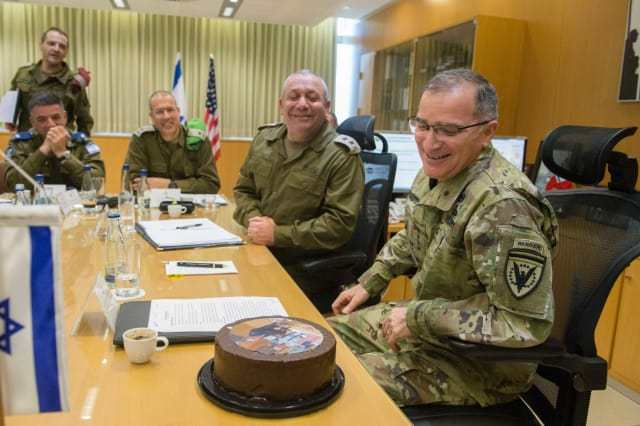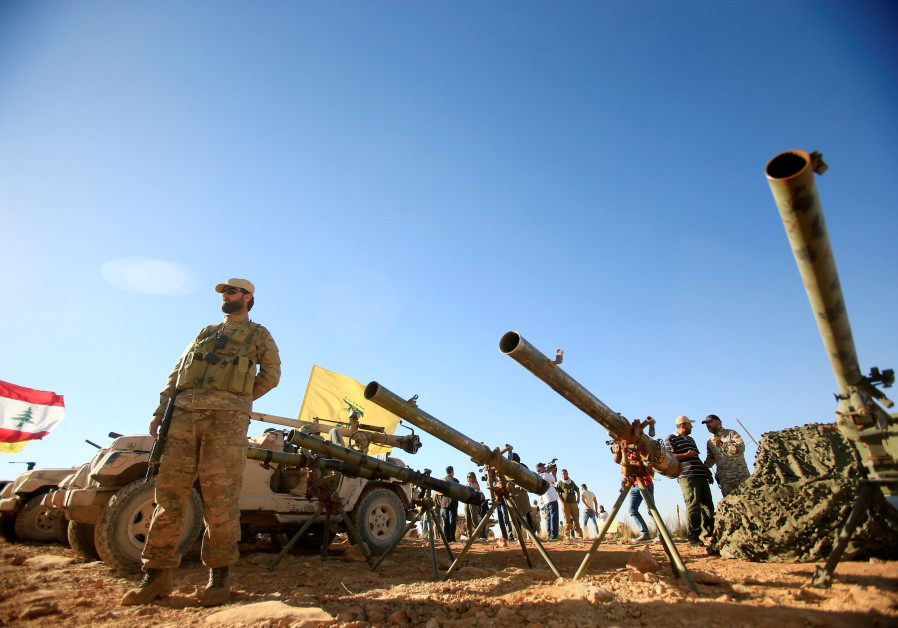Intelligence sources said “Israel wants Syria to return to the era before 2011 when the leaders of the country were less powerful and experienced than they are today after seven years of warfare, the delivery of Russian advanced equipment mostly for air defence, the supply and manufacturer of sophisticated Iranian missiles in Syria and the formative presence of Iranian and Hezbollah advisors”. The sources reveal that “Israeli officials told their American counterparts that it would be inappropriate to withdraw forces from the northeast of Syria, leaving Iran and its allies behind. The withdrawal – which now seems partial – of US forces should be done, if not before, at least simultaneously with the departure of all foreign forces operating on Syrian soil to create a balance of power on the ground. Also, it is important to stipulate that President Bashar al-Assad must refrain from using his mid-range precision missiles against Israel any time in the future as part of any US withdrawal from Syria deal. Israel argued that the US is delivering the Levant to Russia and the ‘Axis of the Resistance’ without any concessions in return”, according to the source.
The US establishment seems unwilling to cater to Israeli’s exaggerated anxieties. US officials visiting Tel Aviv told local officials that “the Israeli army holds enough military power to defend itself and that since 1974 Israel has no longer been on the defensive in the region. On the contrary, Israel has been on the offensive, taking the initiative to attack targets in Syria during these seven years of war”. According to western officials, the US reminded Israel that thousands of American forces are based in the country, in the Mediterranean and in various military bases the Middle East. These can intervene in favour of Israel in a timely way whenever appropriate. Therefore, Israel should stop screaming for unneeded help, when it is the one inflicting damage on its adversaries”.
Israel has repeatedly bombed targets in Syria belonging to the Syrian army and the “Axis of the Resistance”. It pushed the red lines even further when it bombed Iranian officials at the T4 airbase in 2018, killing several Iranian officers. In 2019, Israel already bombed a warehouse at Damascus airport, hours after the off-loading of Iranian military cargo. Although most of the Israeli missiles were shot down, a few managed to reach their target. Nevertheless, these bombings have little meaning on the strategic level because, although Israel has shown the long reach of its missiles, it has dramatically failed in its goal of crippling the missile capability of Syria and of Hezbollah in Lebanon and Syria. During his recent visit to Cairo US Secretary of State Mike Pompeo said that Hezbollah today has “over 130,000 missiles”.
If, as Israeli Chief of Staff General Gadi Eisenkot says, Israel “has complete intelligence superiority in the area” of Lebanon and Syria, how can he explain the arrival and deployment of a hundred and thirty thousands missiles – according to Pompeo – in Hezbollah’s hands? Eisenkot misled the Israelis when he said “Hezbollah possesses no accurate missile capabilities, except for small and negligible ones”. Indeed, when the leader of Hezbollah, Sayyed Hasan Nasrallah, warned Israel that he would “respond against any Israeli attack on Lebanon”, Israel heeded his warning and refrained from attacking any target in Lebanon. Throughout the war in Syria, Israeli jets violated the Lebanese airspace and flew over Lebanon to bomb Syria but didn’t dare to attack any Hezbollah objective in Lebanon, limiting themselves to attacking Hezbollah’s military trucks, Syrian and Iranian objectives in the Levant.

According to well-connected sources, Israeli jets fired warning missiles in front of targeted trucks – before destroying the target later on – to avoid human casualties for fear of Hezbollah retaliation. If Israeli intelligence about the supposedly limited military power of Hezbollah is accurate, it makes no sense for Eisenkot to boast about his allegedly almighty military power against a “negligible enemy,” as he describes the military capability of the Lebanese “party of God”.
Sources operating in Syria and Lebanon agree with Israeli statements that Israel has bombarded various objectives in Syria with thousands of bombs, as announced by Prime Minister Netanyahu. Nevertheless, they claim that only 5% of the total weapon supply was intercepted and destroyed.
“Israel’s bombing of targets in Syria has been neither strategic nor tactical. They were political attacks aimed at boosting Netanyahu’s image. These strikes did not weaken the Iranian Revolutionary Guards Corps (IRGC) nor Hezbollah. Israel contradicts itself all the time. For example, the Israelis say: Hezbollah is the fifth most powerful force in the world, but is very weak and has limited power… Hezbollah is digging four tunnels which represent a serious threat to Israel’s national security, etc.”, said the source.
In fact, Israel has not provoked or attacked Hezbollah since the 2006 war. The only serious attack was registered in 2015 by a drone in Quneitra that killed Jihad Mughnnieh and the Iranian General Mohammad Ali AllahDade. The attack was not planned but rather an opportunistic attack on an Iranian-Hezbollah convoy of 3 four-wheel drive vehicles who spent several hours playing in the snow in an area in sight of an Israeli observation point. Israel didn’t know who was the target and certainly was unaware of the presence of the IRGC General. In retaliation, Hezbollah attacked an Israeli patrol in the Shebaa Farms killing several soldiers and an officer. Israel turned a blind eye and the tit-for-tat was closed between the two sides.
President Assad and his allies believe that Israel is trying to provoke Syria to respond to its violations of Syrian sovereignty in order to postpone or avoid a US withdrawal from Syria.
President Assad and his allies believe that Israel is trying to provoke Syria to respond to its violations of Syrian sovereignty in order to postpone or avoid a US withdrawal from Syria. For this reason, they prefer to not respond directly to Israeli provocations, in the expectation of a US withdrawal. Nevertheless, President Trump’s recent comments about “a 20 mile buffer zone” on the borders is an indication that he now intends to keep some forces in Syria and carry out only a partial rather than a full withdrawal of US troops.

Syria and its allies will need to reassess their strategy in response to Israeli aggression and US occupying troops when the dust settles in the northeast of Syria. So far, it is impossible to ascertain what Trump will decide in view of his ongoing contradictory statements about the US occupation of Syria.
Notwithstanding Trump’s intentions towards Syria and his fickle withdrawal plans, Israel has failed in all of its objectives in Syria: the Syrian government is still in place, the army has been rebuilt and Hezbollah and Iran have trained local fighters who are determined to stand against Israel in due course. Today, in 2019, Hezbollah has received all the missiles and different weaponry needed – as Pompeo has admitted– and Iran is a source of great concern for Israel and the US, present on its Syria front where before it was present only on the borders with Lebanon. Therefore, Israel, despite its heated media declarations and the thousands of targets it has hit in Syria in recent years, feels much more vulnerable today than it did in 2011.
Also, the Iraqi front cannot be discounted: al-Hashd al-Shaabi, the Iraqi Popular Mobilisation Force, was created in 2014 to stand against ISIS. Today it is made up of tens of thousands of men highly trained and equipped with a strong ideology comparable to that of Hezbollah and Iran. Iranian influence has expanded from Lebanon to Syria and Iraq. Israel has grounds for concern.
But that is not all: Iran is present in Yemen where Saudi Arabia’s destructive war against the Houthis has offered Iran a unique opportunity to support the oppressed against the oppressor. Iran has also managed to create a foothold in Afghanistan: the Taliban leader Mullah Akhtar Mansour was invited to Tehran along with a high-ranking Taliban delegation. Iran licked its wounds when the Taliban killed ten Iranian diplomats in Mazar i-Sharif and eventually managed to overcome its differences with the Taliban for the greater cause of standing up to US hegemony in Afghanistan.
Iran and Syria have shown patience in biding their time and building their strength. After its 1979 revolution Iran’s government had little international experience. It began support of Hezbollah in 1982. Thirty-five years later, Hezbollah has become an organised irregular army present on many Middle Eastern fronts. While Israel may enjoy provoking Syria with tactical attacks and thousands of bombardments against various targets, the new strategic reality is inescapable. Both Iran and Syria have survived continuous threats and wars and have managed to pull through stronger. At the same time Israel, a nuclear power with the strongest air force in the Middle East, is to-date refraining from attacking Lebanon, a small country hardly visible on the world map. Israel is deterred by three words from Sayyed Nasrallah to the powerful Tel Aviv leaders who enjoy the unlimited support of a superpower (USA): Don’t try us!
Cover photo: A Satellite image of T-4 airbase in Syria. Photo: DigitalGlobe/European Space Imaging






